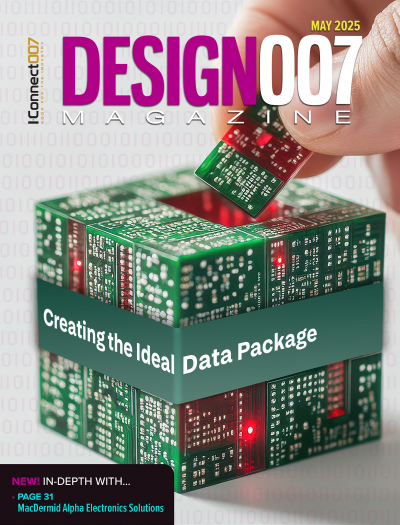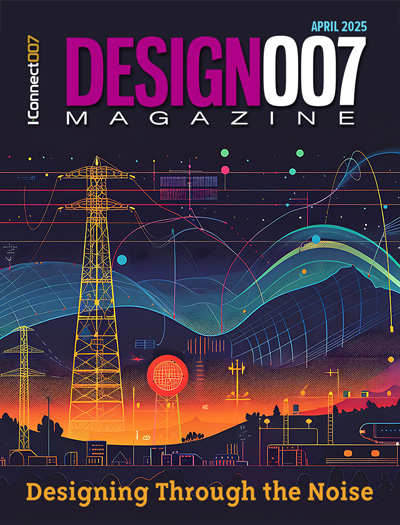-

-
News
News Highlights
- Books
Featured Books
- design007 Magazine
Latest Issues
Current Issue
All About That Route
Most designers favor manual routing, but today's interactive autorouters may be changing designers' minds by allowing users more direct control. In this issue, our expert contributors discuss a variety of manual and autorouting strategies.

Creating the Ideal Data Package
Why is it so difficult to create the ideal data package? Many of these simple errors can be alleviated by paying attention to detail—and knowing what issues to look out for. So, this month, our experts weigh in on the best practices for creating the ideal design data package for your design.

Designing Through the Noise
Our experts discuss the constantly evolving world of RF design, including the many tradeoffs, material considerations, and design tips and techniques that designers and design engineers need to know to succeed in this high-frequency realm.
- Articles
- Columns
- Links
- Media kit
||| MENU - design007 Magazine
Estimated reading time: 4 minutes
Contact Columnist Form
Target Condition: Are Autorouters Friend or Foe?
For PCB designers, just hearing the word “autorouters” can trigger everything from eye rolls to heated debate. We all have stories—some painful, some comical—of boards gone sideways at the hands of an overzealous routing algorithm. But these tools aren’t going away, and frankly, they shouldn’t. Used wisely, they can save some project teams hours or even days. Used blindly, they can cost weeks. So, where do autorouting tools stand today, and is interactive routing the smarter path forward?
Let’s be honest, autorouters didn’t earn their bad rep for nothing. Back in the day, running a full autorouter was a bit like rolling the dice: You didn’t know what you would get, but it probably wasn’t pretty. The results were often a tangled mess of vias, long trace lengths, and questionable design choices that no self-respecting engineer would sign off on. We treated autorouting the way you treat a week-old fish taco left on the lab bench: technically still there and available, but you’d really rather not eat it.
That said, routers have changed. Today’s autorouters are much smarter. They understand constraints, manage differential pairs, and even tiptoe around impedance considerations—most of the time. They are less of a bull in a china shop and more like an over-eager intern: It needs supervision, but it might help you out if you guide it.
Don’t Be a Passenger on Your Own Design
Here’s the real kicker: You still have to double-check the autorouter’s work—not just casually glance it over, but really inspect it. Using an autorouter and performing a critical review of the results is like driving a Tesla in autopilot mode with a blindfold. You might arrive at your destination, but you’ll have no idea how you got there. If you have to retrace your route, forget it. You're lost.
Now, think about how Tesla autopilot is actually meant to be used: hands on the wheel, eyes on the road, fully alert and ready to take over. That’s the mindset you need when using an autorouter. Let it handle the grunt work, but you’re the one watching the road.
If you don’t (and I’ve seen this firsthand), you’ll end up with an autorouted board that technically passes DRC but fails in the real world. You’ll have power integrity issues, timing errors, and EMI nightmares, all because you didn’t stay engaged with the layout.
Interactive Routing: Designing with Power Steering
Enter interactive routing, the middle ground I think most seasoned designers live in today. Think of it as power steering for PCB layout. You guide the trace or even the bus, and the tool handles the heavy lifting, shoving, hugging, tuning, and rule-checking as you go.
It’s a true collaboration between designer and tool. You’re not giving up control; you’re just speeding up the journey without compromising direction. Once you’ve routed a tight BGA breakout or tuned a high-speed differential pair with a good interactive router, you’ll wonder how you ever did it the old way. It’s not just better, it’s smarter.
Depending on the types of layouts you do, autorouting tools have the potential to help your layout workflow if you know when and where to use them. I can see them continuing to help in these areas:
- Bulk routing for general inputs/outputs, test points, and LED arrays
- Quick validation of floor plans and feasibility studies
- Clean-up duty once the performance-critical signals are established
But would I turn an autorouter loose on high-speed nets or RF sections? Even today, that can still be asking for trouble. Some roads still require a hands-on driver with a feel for the terrain.
Why It Matters
In this column, I typically share tips about how a design action can help other PCB process stakeholders do their jobs better. The decision to use an autorouter ultimately comes down to one thing: saving time for the designer. That’s it. No one else in the PCB manufacturing chain cares whether a board was autorouted, manually outed, or routed by a team of caffeinated squirrels.
Fabricators want clean, manufacturable designs. Assembly houses want reliable layouts that pass inspection. Test engineers want accessibility and signal integrity. None of them benefit just because a designer saved a few hours by clicking “autoroute.” If the result is a clean, working layout, great. If it isn’t, you’ll be the one fixing it, not them.
So, while autorouting tools are improving—and AI is pushing them even further—their role remains narrow: They can be a time-saver for the designer, but not a quality assurance tool.
The best designers I know use automation selectively. They lean on interactive routing for control and clarity, and they keep autorouting in its lane for grunt work, not guidance. Used with care, autorouting can help clear out low-priority traces or validate feasibility. But in the short term (before many of us retire), it just can’t replace the skill, judgment, and hands-on finesse required for complex or performance-critical designs.
When it comes to autorouting, much like with the week-old fish taco, you don’t want to take a bite unless you’ve given it a good, hard look first.
This column originally appeared in the June 2025 issue of Design007 Magazine.
More Columns from Target Condition
Target Condition: From Dream House to Drill FilesTarget Condition: Designing vs. Inventing
Target Condition: ‘Boomer to Zoomer: Do You Copy?’
Target Condition: Advanced Packaging Technologies—Look Before You Leap
Target Condition: My Anti-venom to PCB Cost Adders
Target Condition: Taking the Stand at Your Own Design Review
Target Condition: Designing Unconventional Geometries
Target Condition: What the Heck? A PCB Tech Spec Check


